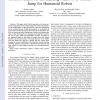Free Online Productivity Tools
i2Speak
i2Symbol
i2OCR
iTex2Img
iWeb2Print
iWeb2Shot
i2Type
iPdf2Split
iPdf2Merge
i2Bopomofo
i2Arabic
i2Style
i2Image
i2PDF
iLatex2Rtf
Sci2ools
IROS
2006
IEEE
2006
IEEE
Motion Pattern for the Landing Phase of a Vertical Jump for Humanoid Robots
Abstract— This paper deals with the generation of motion pattern for humanoid robots vertical jump. The study concentrates on the landing phase of the jump which is the most demanding for the system because of high discontinuity of acceleration at impact time. We first decompose the motion in two functions. The first one starts just before landing and consists in maximizing the value of the discontinuity by reducing the feet/ground velocity. We set the feet, COM and feet/COM velocities according to the supposed height of the jump. At impact time, the second function uses measured data of Ground Reaction Force (GRF) from the ankle force sensors to quickly stop the system while keeping its vertical equilibrium. The influence of each function and their respective parameters is discussed and analyzed, and their validity is tested using the model of an existing humanoid platform.
| Added | 12 Jun 2010 |
| Updated | 12 Jun 2010 |
| Type | Conference |
| Year | 2006 |
| Where | IROS |
| Authors | Sophie Sakka, Ee Sian Neo, Kazuhito Yokoi |
Comments (0)

